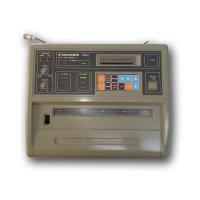
Do you have a question about the Furuno DFAX FAX-208/A/N and is the answer not in the manual?
| Model | FAX-208/A/N |
|---|---|
| Recording Method | Thermal recording |
| Weight | 3.5 kg |
| Type | Weather Facsimile Receiver |
| Paper Size | 210mm (width) x 30 m (length) roll paper |
| Power Supply | 24 V DC |
| Dimensions | 100 mm |
| Scanning Speed | 60, 90, 120 rpm |
Precautions for proper installation, considering water spray, shock, heat, and noise.
Instructions for mounting the recorder unit on a bulkhead or table-top, considering paper path.
Guidance on installing the antenna for optimal performance, including passive and active antennas.
Instructions for connecting power, antenna, and ground cables to the receiver.
Setting the internal slide switch (S1) to "ACTIVE" when the preamp unit is installed.
Description of front panel controls and touchpads.
Description of MODE and RCL/PRG keys and their functions.
Explanation of the function of each LED indicator.
How to turn the unit on and off using the POWER button.
Procedure to reset the unit to default settings if memory data is jumbled.
How to set the unit's internal clock to local time or GMT.
How to set scanning speed (SPD) and index of cooperation (IOC).
How to compensate for phase mis-matching to align the picture.
How to activate automatic stop of recording using timer or remote sleep.
How to preset up to 16 programs for timer recording.
Procedure to update a station's frequency in the memory.
How to add new frequency data into the extra memory area.
How to recall or print stored frequency data.
Step-by-step guide to selecting Navtex stations and messages.
How to monitor the Navtex signal instead of the facsimile signal.
Table of check items and actions for periodic inspection.
Procedure and precautions for replacing fuses.
How to clean the unit, including the thermal head.
Table of symptoms, possible causes, and remedies for common issues.
Self-test procedure for the Navtex receiver board.
Self-test procedure for the master CPU and related boards.
Technical specifications for the recorder section.
Technical specifications for the receiver section.
General technical specifications including power, dimensions, and environmental conditions.
List of materials required for installation.
List of spare parts and accessories available.
Detailed explanation of the radio facsimile transmission and reception principle.
Explanation of the Navtex system, its operation, and frequency usage.
Detailed breakdown of the Navtex message header and its components.
Description of rear panel terminal boards for external connections.
How to connect devices to the Navtex alarm output.
Installing an external break-in relay for protection against RF induction.
Adjusting the print intensity using internal switches.
Changing the vertical-horizontal ratio of the picture recording.
Adjusting the internal beep sound level.
Criteria for when modification is necessary or not.
Instructions for additional ground wire connection if factory-added wire is insufficient.